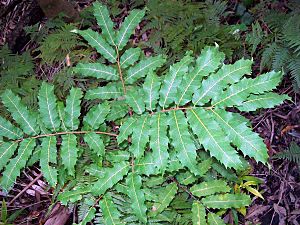Cupaniopsis newmanii facts for kids
Quick facts for kids Cupaniopsis newmanii |
|
|---|---|
 |
|
| Scientific classification | |
| Genus: |
Cupaniopsis
|
| Species: |
newmanii
|
The Cupaniopsis newmanii is a special plant that grows in rainforests. It belongs to the soapberry family, just like the plants that give us lychees! People often call it the long-leaved tuckeroo because of its long leaves. This plant is quite rare. You can find it growing naturally in eastern Australia, from Mullumbimby in New South Wales all the way up to Gympie in south-eastern Queensland. It loves warm, wet places like subtropical rainforests.
Contents
About the Long-Leaved Tuckeroo
The long-leaved tuckeroo can grow as a large bush or a small tree. It can reach up to 6 metres (about 20 feet) tall. Its main stem can be about 5 centimetres (2 inches) wide. This plant is very pretty, especially in spring when its new leaves are a lovely pinkish-red colour. In autumn, it produces bright, colourful fruits.
The trunk of the tree is often a bit bent or crooked. It has dark grey or black bark. This bark has interesting vertical lines and cracks. The smaller branches are quite thick. Young shoots and branchlets are covered in rusty brown hairs.
What Its Leaves Look Like
The leaves of the long-leaved tuckeroo are quite long, usually 35 to 45 centimetres (14 to 18 inches) in length. Each long leaf is made up of 16 to 24 smaller leaflets. These leaflets are shaped like an oval or a reverse spearhead. They are 6 to 13 centimetres (2.5 to 5 inches) long and 2.5 to 5 centimetres (1 to 2 inches) wide.
The leaflets grow in pairs or slightly offset from each other along the main leaf stem. They have sharp, noticeable teeth along their edges. The base of each leaflet is a little uneven. The top side of the leaflets is dark green, while the underside is paler. The main stem of the leaf is 8 to 16 centimetres (3 to 6 inches) long. Each small leaflet has its own short stem, about 1 to 3 centimetres (0.4 to 1.2 inches) long. This small stem is smooth but has a groove on its upper side.
If you look closely at a leaflet, you'll see about 15 pairs of side veins. These veins go all the way to the edge, ending in one of the leaf's teeth. It's easier to see these veins if you look at the underside of the leaf. The main vein (midrib) looks sunken on the top of the leaf but is raised on the bottom.
Flowers, Fruit, and New Plants
Pink flowers appear on the plant from July to October. They grow in clusters called panicles from where the leaves join the stem. The fruit is a round, orange-red capsule with three sections. It's about 2 centimetres (0.8 inches) across.
Inside the capsule, you'll find a yellow covering called an aril. This aril surrounds one to three shiny black seeds. These seeds are quite large, about 15 to 20 millimetres (0.6 to 0.8 inches) long. The fruit ripens from October to November. What's cool is that new plants grow very quickly from fresh seeds. Most seeds will sprout after just a week or two!
See also
 In Spanish: Cupaniopsis newmanii para niños
In Spanish: Cupaniopsis newmanii para niños

